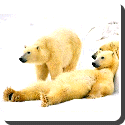 Bear Polar — The polar bear (Ursus maritimus) is a bear native to the Arctic. Polar bears and Kodiak bears are the world’s largest land carnivores, with most adult males weighing 300–600 kg (66–1320 lb); adult females are about half the size of males. Its fur is hollow and translucent, but usually appears as white or cream colored, thus providing the animal with effective camouflage. Its skin is actually black in color. Its thick blubber and fur insulate it against the cold. The bear has a short tail and small ears that help reduce heat loss, as well as a relatively small head and long, tapered body to streamline it for swimming.
Bear Polar — The polar bear (Ursus maritimus) is a bear native to the Arctic. Polar bears and Kodiak bears are the world’s largest land carnivores, with most adult males weighing 300–600 kg (66–1320 lb); adult females are about half the size of males. Its fur is hollow and translucent, but usually appears as white or cream colored, thus providing the animal with effective camouflage. Its skin is actually black in color. Its thick blubber and fur insulate it against the cold. The bear has a short tail and small ears that help reduce heat loss, as well as a relatively small head and long, tapered body to streamline it for swimming.
A semi-aquatic marine mammal, the polar bear has adapted for life on a combination of land, sea, and ice, and is the apex predator within its range. It feeds mainly on seals, young walruses, and whales, although it will eat anything it can kill.
The polar bear is a vulnerable species at high risk of extinction. Zoologists and climatologists believe that the projected decreases in the polar sea ice due to global warming will reduce their population by two thirds by mid-century. Local long-term studies show that 7 out of 19 subpopulations are declining or already severely reduced. In the USA, the Center for Biological Diversity petitioned to list the polar bear as an endangered species under the U.S. Endangered Species Act in 2005. The U.S. Fish and Wildlife Service formally proposed to list the polar bear as a threatened species on January 9, 2007. A final decision was due on January 9, 2008 but has been delayed.
A polar bear’s fur provides camouflage and insulation. Although the fur appears white, in fact the individual hairs are translucent, like the water droplets that make up a cloud; the coat may yellow with age. Stiff hairs on the pads of a bear’s paws provide insulation and traction on the ice.
Polar bears gradually molt their hair from May to August; however, unlike other Arctic mammals, polar bears do not shed their coat for a darker shade to camouflage themselves in the summer habitat. It was once conjectured that the hollow guard hairs of a polar bear coat acted as fiber-optic tubes to conduct light to its black skin, where it could be absorbed—a theory disproved by recent studies.
 Kids Portal For Parents India Kids Network
Kids Portal For Parents India Kids Network






